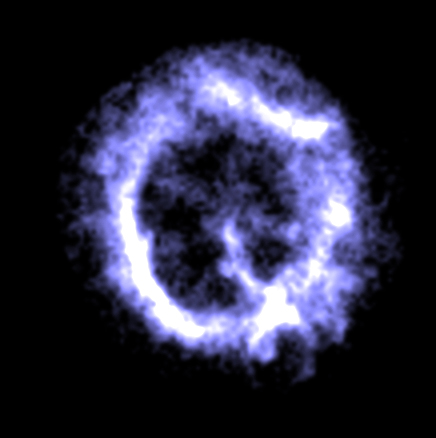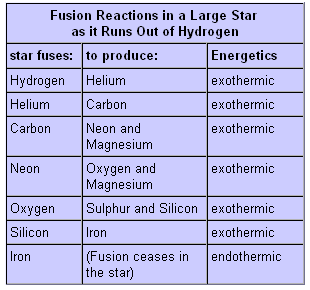Neutrino Astrophysics
Supernova 1987A: first supernova observed in neutrinos
Very large stars can end their lives in a cataclysmic explosion called a supernova. The photographs show a supernova in the Large Magellanic Cloud, a satellite galaxy of the Milky Way located only about 160,000 light years away. Photographed in 1987, and named 1987A, it was the first supernova visible to the naked eye since early in the seventeenth century. In fact, at its brightest, a typical supernova outshines all the other stars combined in its galaxy.
Astrophysicists have predicted that a supernova explosion would produce a sharp pulse of neutrinos, the elusive uncharged particles that move at or near the speed of light. Neutrinos interact with matter hardly at all and are therefore extremely difficult to detect. In 1987 two big detectors were up and running, part of the field of experimental neutrino physics, and they observed neutrinos from supernova 1987A.
Neutrinos carry nearly all of the energy of a supernova explosion. After the explosion of 1987A, the two detectors observed an increase of 19 neutrino counts, the first ever observation of neutrinos produced by a supernova. Moreover, the neutrinos arrived in a pulse about three hours before the visible light from the supernova, just as astrophysicists had predicted.
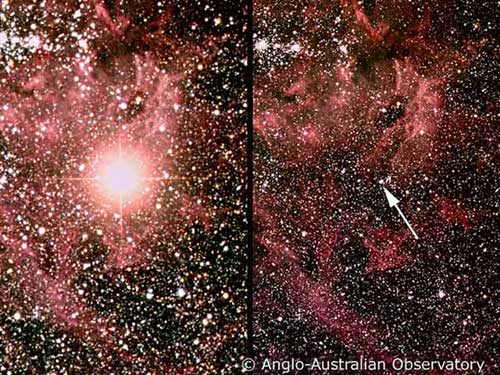
Supernova 1987A (left) Star field before explosion (right) Copyright Anglo-Australian Observatory. Photograph by David Malin.
Neutrino properties
- uncharged
- little or no mass
- moves near or at the speed of light
- interacts with matter only through
- the weak nuclear force
The neutrino was predicted in 1930 but observed only in 1956.
A free neutron decays, with a lifetime of about 15 minutes, to a proton, an electron, and a neutrino.
n –> p + e- + n
Neutrinos are produced in large numbers by the fusion of hydrogen to helium in the interiors of adult stars. Although this reaction is well understood, the observed counts of solar neutrinos are only about half what theory predicts—a longstanding puzzle.
More Information on Supernovae
A star lives in the grip of two opposing forces:
- Gravity attracts all the matter in the star toward its center.
- The energy from fusion heats the star and produces the pressure needed to counteract gravity.
For most of its life a star produces energy by fusing hydrogen to make helium. When the hydrogen becomes depleted, the star's core heats up and begins to fuse the accumulated helium to make carbon. This process, as shown in the table, produces heavy elements up to iron. However, unlike the previous reactions, the fusion of iron ABSORBS energy and leads to the catastrophic collapse of the star's interior. In the resulting explosion, fusion reactions produce all elements heavier than iron in the universe. In the beginning of the universe, the big bang explosion created matter that was about 75% hydrogen, 25% helium, and a small amount of lithium. All heavier elements in the solar system were created in an earlier generation of stars and blown off into space by supernova explosions.
The supernova described here, produced in the death of a large star, is called a Type II supernova. Another kind, Type I, can occur in a binary system containing a small collapsed star.
The Solar Neutrino Problem
Although billions of neutrinos traverse every square centimeter of the earth each second, observing them is difficult since they only interact with matter through the, appropriately named, weak force, which is so weak that most neutrinos pass through the entire Earth without interacting even once. However, with complex equipment and lots of time, a very few of these neutrinos can be detected.
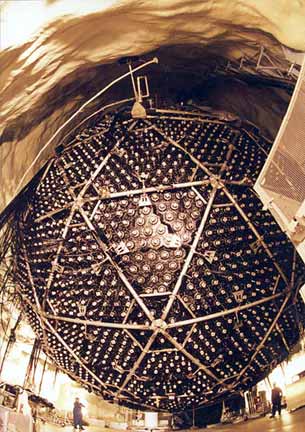
Sudbury Neutrino Observatory —designed to catch solar neutrinos. Shown here is an external view of the detector. Photo courtesy of Lawrence Berkeley National Lab.
Stars, like our sun, produce HUGE amounts of neutrinos—over two hundred trillion trillion trillion— every second. But this pales in comparison to a supernova--like 1987A--which emits1000 times more of these elusive particles than the sun will produce in its 10-billion year lifetime.
Neutrinos that originate in the sun are called solar neutrinos. Since they escape the sun's core unimpeded, these solar neutrinos, when detected, can provide information about the reaction processes deep inside the sun. However, data from several neutrino detectors reveal only approximately half the number of neutrinos that are expected from prevailing theories. This is a puzzle commonly known as the Solar Neutrino Problem..
A new detector, the Sudbury Neutrino Observatory (SNO), located in Sudbury, Ontario, Canada, may offer a solution to this problem. Neutrinos are known to come in three types commonly referred to as "flavors." The neutrinos produced by the sun are electron "flavored," and all neutrino detectors before SNO were designed to observe only these neutrinos. Recent findings suggest the possibility that as they propagate through space neutrinos can transform themselves, or "oscillate", from one flavor to another. So, while experiments were counting only electron neutrinos, other flavored solar neutrinos could have been passing through the detectors unnoticed. SNO, which began taking data in 1999, is designed to detect all three flavors of neutrinos. If the experiment confirms neutrino flavor oscillation, SNO will earn its nickname—our window on the sun.
Links
University of California at Berkeley
Space Telescope Institute
NASA
Imagine the Universe
Anglo-Australian Observatory
University of Michigan
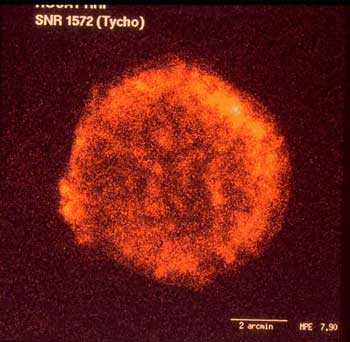
X-ray image of the remnants of a supernova originally observed by Danish astronomer Tycho Brahe in 1572. Courtesy of NASA.










